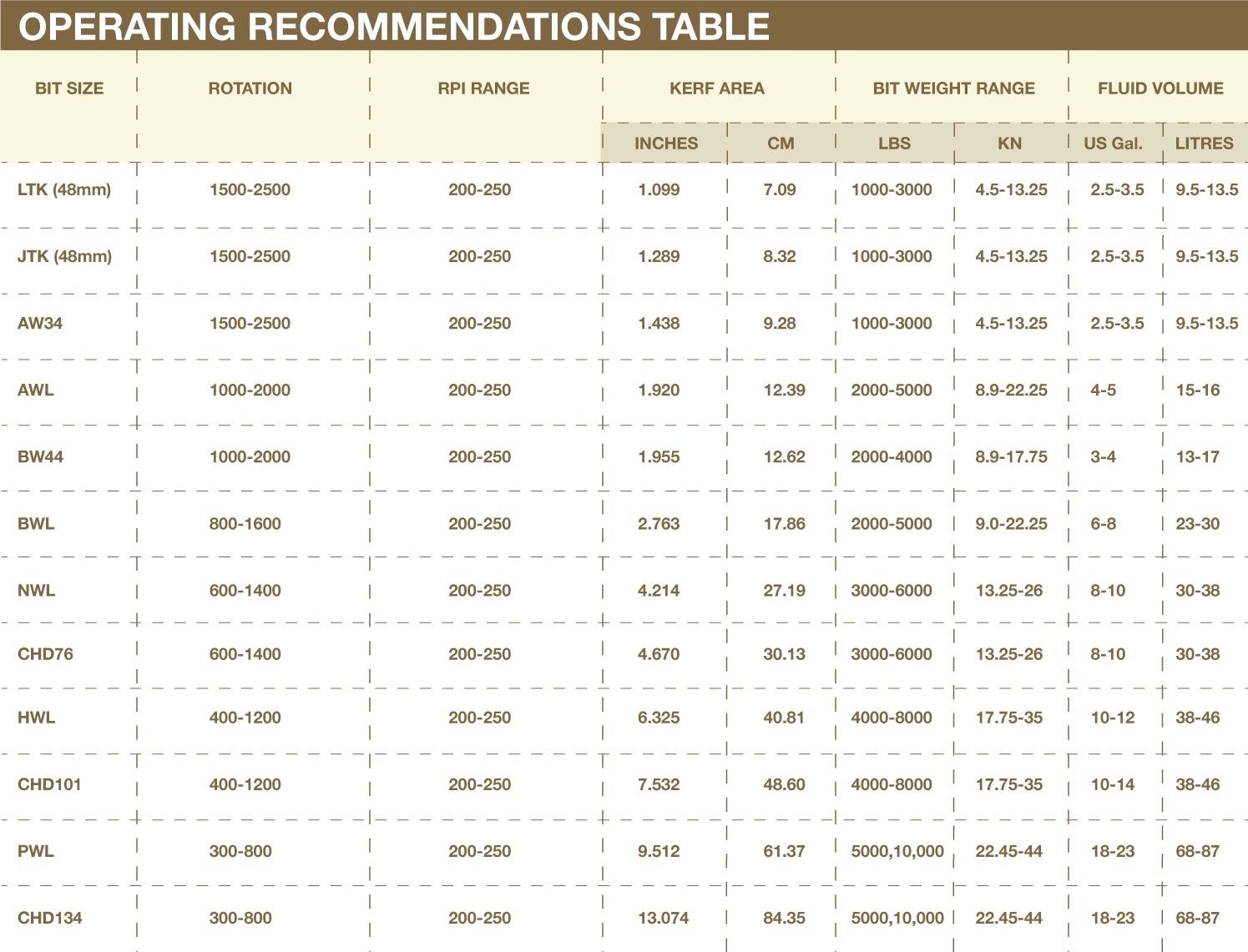Drilling Solutions
(Operating Recommendations Table, Fluid Velocity, String Stability, Rotational Speed Relative to Penetration (RPI), Bit Weight, Sharpening Techniques and Bit Wear Patterns)
Parameters Contributing to Drilling
• Fluid Velocity
Fluid flow is another critical variable in optimizing drilling efficiency. The fluid must effectively cool the bit and remove the cuttings from the bit face and then transport these cuttings up the annulus of the hole to the surface as efficiently as possible. Fluid volume should be increased as penetration rates increase. The velocity of the fluid and its carrying ability of the cuttings depend on the fluid viscosity. Generally, cuttings should always have an upward velocity of 4 in/sec. (10 cm/sec).
Too much fluid volume can cause hydraulic lift that seriously affects actual bit weight and consequently drilling performance. If the fluid flow is too low, the bit can wear prematurely due to the abrasive action of the cuttings. In very hard fine-grained formations, fluid velocity can be intentionally reduced to increase matrix erosion to expose new diamonds.
String Stability
In all recommended operating parameters it is important to select a combination of RPM and Weight that minimizes or preferably eliminates drill string vibration.
Factors contributing to drill string vibration are:
• Misalignment of the drill string with the hole
• Operating within critical ranges of the drill string
• Excessive bit weight or rotation speed
• Bent core barrel or rods
• Oversize annulus
Rotational Speed Relative to Penetration (RPI)
Optimum rotational speeds depend on the formation types being drilled and inter-relationship between the rig capabilities, peripheral equipment being used, and the individual drilling styles.
RPI (revolutions per inch) is singularly the most important factor to consider when trying optimizing bit life and productivity. It is a ratio of the rotational speed (rpm) to the penetration rate. (If the RPI is too low, premature diamond loss from the matrix is very likely. Conversely, if the RPI is too high, it is very likely that the diamonds will become polished and penetration rates will fall off.)
Maintaining a good RPI ensures that the diamonds stay exposed and that the bit wears at an even and controlled rate. Ideally, the RPI should be between 200 – 250 for all impregnated drill bits. Factors such as drill string vibration or rig constraints might prevent operating within an optimum RPI range, in which case a lower ratio should be used to optimize the bits performance under adverse drilling conditions.
Bit Weight
The weight applied to the drill bit is the other important variable in optimizing bit life and achieving a desired RPI. The weight has to be sufficient to maintain a rate of advance relative to the rotational speed (to keep the bit penetrating), as indicated by the RPI factor. However, a weight that is too high can cause diamond re-impregnation or rapid wear due to stripping or even a mechanical failure of the matrix. Too low of a weight often leads to the diamonds becoming polished, requiring the matrix to be stripped to expose a new layer of diamonds.
Ideally, the matrix being used performs best when it wears at the same rate as the diamonds. If the matrix requires continues stripping to achieve an acceptable penetration rate, then a softer matrix (higher Hayden number) should be used.
As a guideline, the weight on an impregnated bit should never exceed 2000-2500 psi or (1378 N/cm²-1723 N/cm²).
Sharpening Techniques
If the bit becomes polished, glazed or dull. There are various techniques to sharpen the matrix and expose new diamonds.
• Reduce water flow
• Increase Drilling Pressure
• Increase Drilling Pressure and reduce water flow
• Reduce water flow and RPM
Bit Wear Patterns
The bit wear pattern is a good reference for operator to troubleshoot the problems through the given recommended resolutions. In accordance to drill’s operating parameters recommendations and bit matrix / waterways specifications, the operators can simply alter configurations that is best suited to the ground condition.

